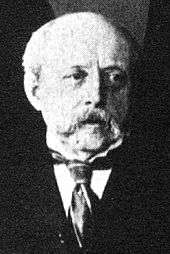Charles E. Barber
| Charles E. Barber | |
|---|---|
 | |
| Chief Engraver of the U.S. Mint | |
|
In office August 31, 1879 – February 18, 1917 | |
| President |
List of Presidents
|
| Preceded by | William Barber |
| Succeeded by | George T. Morgan |
| Personal details | |
| Born |
Charles Edward Barber November 16, 1840[1] London, England, United Kingdom |
| Died |
February 18, 1917 (aged 76) Philadelphia, Pennsylvania, United States |
| Occupation | Engraver |
Charles Edward Barber (November 16, 1840 – February 18, 1917) was the sixth Chief Engraver of the United States Mint from 1879 until his death in 1917.
Although Barber's coins were met with mixed reviews, he had a long and fruitful career in coinage, designing most of the coins used at the mint during his time as Chief Engraver. Barber did full coin designs and also reverse designs.
History
Barber was born in London in 1840, the son of William Barber. In 1869, he was an assistant engraver at the United States Mint.[2] In 1879, he succeeded his father, in the position as chief engraver. Barber's best-known designs are the eponymous "Barber" Barber dime, Barber quarter, and Barber half dollar, as well as the so-called "V" Liberty Head nickel.
Some lesser known pattern coin designs by Barber include the trial copper-nickel cent, trial three-cent piece, and the $4 Stella "Flowing Hair" pieces. Citing the impracticality of the design, he was strongly critical of Augustus St. Gaudens' proposed high relief pattern for a new double eagle in 1908, and tried hard to stop them being produced.[3] Barber was succeeded as Chief Engraver by George T. Morgan.
.png)
Coins Designed
Public Issues
Commemoratives
- Flowing Hair Stella
- The obverse (front) of the Columbian Exposition half dollar
- Isabella Quarter
- Silver Lafayette Dollar
- Louisiana Purchase Exposition gold dollar
- Lewis and Clark Exposition gold dollar
- Panama-Pacific Exposition half dollar
- William McKinley Memorial gold dollar
Pattern coins
References
- ↑ "Charles E. Barber". Nps.gov.
- ↑
- ↑ Numismatic Guaranty Corporation. "St. Gaudens $20 (1907-1933)". Numismatic Guaranty Corporation |. Retrieved 29 July 2013.
| Government offices | ||
|---|---|---|
| Preceded by William Barber |
Chief Engraver of the U.S. Mint 1879–1917 |
Succeeded by George T. Morgan |